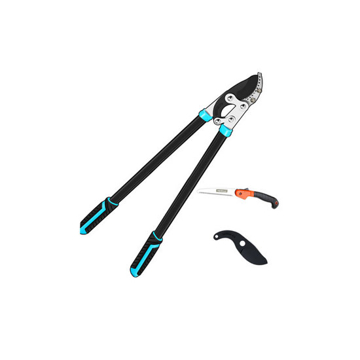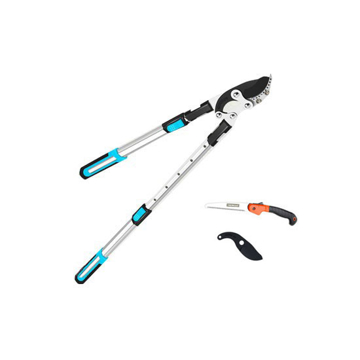Loppers
2 Inch Cutting Capacity 30 Inch Length Lopper
3 Inch Cutting Capacity 32 Inch Length Lopper
26 Inch to 40 Inch Telescopic Ratchet Lopper
28 Inch to 35 Inch Telescopic Ratchet Lopper
Wholesale loppers for sale, the loppers are used for fruit tree pruning and fruit picking operations, loppers handle is operated by the grip of the human hand, driving the opening and closing of the knife, cutting the branches or picking fruits, the operation is convenient and safe. Telescopic ratchet loppers can be extended to a sufficient length to trim high branches.
How to trim trees?
1. First remove the branches that show signs of damage. Regardless of the damage caused by the storm or other reasons, the broken branches should be cut off so that the moisture and nutrients they occupy can be transported to other healthy branches.
2. Prune areas with dense branches. Cut off the crossed branches and remove the cover to allow air to circulate and sunlight to reach every part of the plant. In order for trees to grow healthily, good air circulation is needed between branches. If the branches are too tight, they can breed mold and attract insects. Remove the branches that grow inward and toward the center of the tree. These branches can make people feel cluttered and are not good for the health of the tree.
3. Prune branches that are in the way. Whether it is a relatively low tree branch blocking the walkway, or a high tree branch affecting the telephone line, sticking to the roof, or blocking the top of the house, as long as it causes some trouble for you, you can trim them off.
4. Prune the branches and shape the trees. If you want to create a rounder or neater shape for the tree, cut off the branches that protrude out and are angled strangely; a little pruning will make a big difference.
5. Trim as little as possible. Each pruning will destroy the tree's own defense system, making it possible to infect mold and insect pests. Prune only where necessary, and the cut part should not exceed 25% of the branches.
6. For most deciduous trees, although there are differences in different species, it is necessary to ensure that at least 2/3 of the branches on the tree are alive. It should be noted that the trunk alone is not enough to guarantee the survival of the tree. Cutting off all the branches will put a lot of pressure on the plant.
7. Do not trim more than once every quarter. Since trees need time to recover, unless the storm has damaged more branches, do not pruning more than once per season.
Prune during the dormant period. Pruning in late autumn or early winter can minimize the loss of sap, so the pressure on the trees is less. Pruning at this time of the year is also good for the trees, because the "wounds" are less likely to be infected with mold or pests at this time, and avoid the late autumn and early winter when they are relatively active.
The tree's leaves are beginning to fall is a good sign, and pruning can begin at this time. This indicates that the trees will be dormant until early spring next year. If the branches are broken by the storm at other times, they can be pruned immediately instead of waiting until winter.
7. Cut a small cut under the branch. You can't cut the branches directly with this initial opening. This is to prevent the branches from getting too close to the trunk when they fold down due to their weight.
This cut should be made on the side of the branch called the branch collar. The branch collar is a small crack in the bark, where each branch grows. The branch collar should remain intact, so do not cut along the trunk.
8. Cut off the branches a few inches away from the trunk. The second cut should cut the branches on the outside of the first cut, which is the side away from the trunk. Clear the branches out of the area, leaving only one root.





